Sailfish Off Isla Mujeres, Mexico–February 9-17, 2008
Thursday, March 13th, 2008 at 8:04 pm by Ken
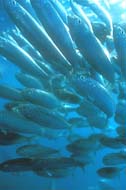 |
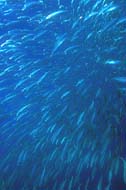 |
| These are the Brazilian sardines (Sardinella brasiliensis) that migrate more than halfway up the east coast of South America to feed in this relatively small area of the Caribbean Sea. If the sardines in that close-up shot on the left look nervous, they have reason to be!
|
|||
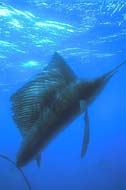 |
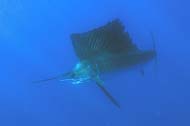 |
||
And here are the Atlantic sailfish (Istiophorus albicans) that are attracted by the sardines. It was hard to focus on individual sailfish, as they moved so quickly. They usually range from six to nine feet in length. That may sound like a large subject, but you had to be pretty close to get something that was more than a small part of the view shown by your wide-angle lens. |
|||
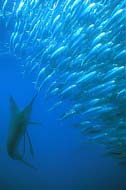 |
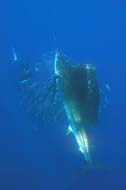 |
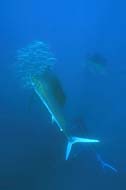 |
|
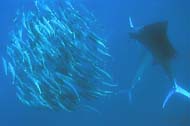 |
|||
|
|
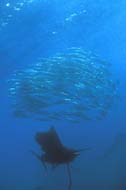 |
||
| The photos above show the sailfish “herding” the sardines to the surface and into baitballs to feed. We found the easiest thing to do was focus the camera on the baitball, then wait for the sailfish to come in. The “sail” is the dorsal fin and it often covers the entire length of the fish’s back. It’s folded down and to the side when the fish swims normally, but is raised when the fish is threatened or excited, to make it appear much larger than it actually is. Groups of sailfish raise their sails to help “herd” the fish schools into baitballs. The baitball moves quickly (so would you if you were a 10-inch fish chased by an 8-foot predator). The photo opportunities were usually when it either moved in your direction, or (infrequently) the baitball might hang out with or beneath us in an attempt to hide. | |||
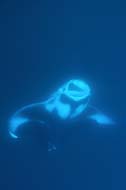 |
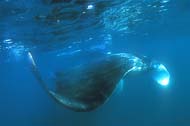 |
| We chartered the boat for seven days, and were able to get to the sailfish on five of them–pretty good, given that it was winter and how far we had to travel. On one of the other two days when the weather didn’t cooperate, we snorkeled with manta & mobula rays in the open water less than an hour from the dock. The rays were feeding on the plankton-rich water, so they stayed around, but that also meant the visibility was terrible–like trying to take photos while swimming in soup (which it actually was–to the rays!) In the above shot at left, the giant manta ray (Manta birostris) was doing an upside-down “barrel roll” while feeding. The shot looks “soft” not because of the focus, but due to the cloudy water. The water looks cleaner in the photo above right, only because I was about two feet from the ray. You can just make out a snorkeler with his camera, above and behind the ray–gives you an idea of the relative size of the manta (they grow to in excess of 20 feet), and also how quickly the visibility decreased if you weren’t VERY close.
|
|
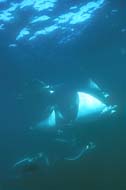 |
|
| While the mantas were solitary feeders, the mobula rays (Mobula sp.) liked to hang out together. Often mistaken for mantas, mobulas are much smaller, rarely over ten feet. |
|
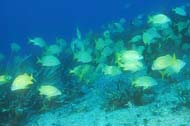 |
|
| On the other day that we were weather-challenged, we put on SCUBA tanks for the only time that week and did a reef dive. I hadn’t heard much about the reef diving around Isla Mujeres, and now perhaps I know why. I was first in the water, and surfaced five minutes later, convinced I’d missed the reef. No–I was on the “reef”–it just didn’t look like what I think of as a reef. Once in a while we’d see an aggregation of fish or a solitary sea fan as above, but not often.
|
|
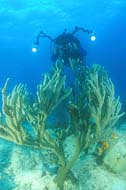 |
|
| Trip Leader Amos Nachoum obligingly modeled for me at one of the few spots of color we encountered on this dive. | |
 |
|
| If the weather is uncooperative and the mantas aren’t feeding, I’d recommend a day trip to the beautiful Mayan ruins at Tulum in lieu of a reef dive. No hike through a jungle is involved–you can picnic on the beach and/or frolic in the warm Caribbean Sea at the same spot. (Note: I visited Tulum and took the two photos above on a different trip)
|
|
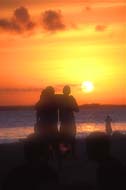 |
|
As usual, I’ll end with a sunset. I knew this trip was a “roll of the dice” because so many things have to go the right way to get the photo–calm seas, sun for ambient lighting and fast shutter speeds, water visibility, subjects present, close and cooperative (or at least preoccupied enough to ignore you), and so on. It was definitely not one of those “Go down the anchor line to the barrel sponge and the frogfish will be just on the left” kinds of trips–so I was happy to get some sailfish images. Best to all, Ken http://www.seaimages.org |
|
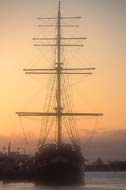
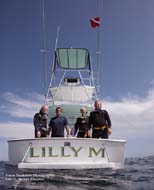
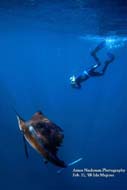
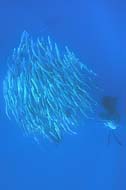
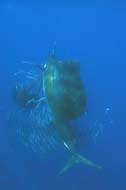
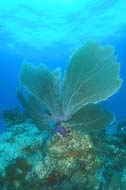
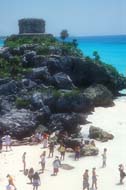
 Permalink
Permalink Filed under:
Filed under: 